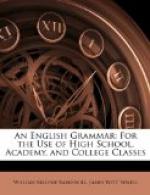III. OMISSION OF THE RELATIVE.
416. Although the omission of the relative is common when it would be the object of the verb or preposition expressed, there is an omission which is not frequently found in careful writers; that is, when the relative word is a pronoun, object of a preposition understood, or is equivalent to the conjunction when, where, whence, and such like: as, “He returned by the same route [by which] he came;” “India is the place [in which, or where] he died.” Notice these sentences:—
In the posture I lay, I could see nothing except the sky.—SWIFT.
This is he that should
marshal us the way we were
going.—EMERSON.
But I by backward steps
would move;
And, when this dust
falls to the urn,
In that same state I
came, return.—VAUGHAN.
Welcome the hour my
aged limbs
Are laid with thee to
rest.—BURNS.
The night was concluded
in the manner we began the
morning.—GOLDSMITH.
The same day I went aboard we set sail.—DEFOE.
The vulgar historian
of a Cromwell fancies that he had determined
on being Protector of
England, at the time he was plowing the
marsh lands of Cambridgeshire.—CARLYLE.
To pass under the canvas
in the manner he had entered required
time and attention.—SCOTT.
Exercise.—In the above sentences, insert the omitted conjunction or phrase, and see if the sentence is made clearer.
IV. THE RELATIVE AS AFTER SAME.
417. It is very rarely that we find such sentences as,—
He considered...me as
his apprentice, and accordingly expected
the same service from
me as he would from another.—FRANKLIN.
This has the same effect
in natural faults as maiming and
mutilation produce from
accidents.—BURKE.
[Sidenote: The regular construction.]
[Sidenote: Caution.]
The usual way is to use the relative as after same if no verb follows as; but, if same is followed by a complete clause, as is not used, but we find the relative who, which, or that. Remember this applies only to as when used as a relative.
Examples of the use of as in a contracted clause:—
Looking to the same
end as Turner, and working in the same
spirit, he, with Turner,
was a discoverer, etc.—R.W. CHURCH.
They believe the same
of all the works of art, as of knives,
boats, looking-glasses.—ADDISON.
Examples of relatives following same in full clauses:—
[Sidenote: Who.]
This is the very same
rogue who sold us the spectacles.
—GOLDSMITH.




